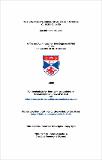Files in this item
The Vivarini workshop and its patrons, c.1430 - c.1450
Item metadata
| dc.contributor.advisor | Humfrey, Peter | |
| dc.contributor.author | Holgate, Ian Richard | |
| dc.coverage.spatial | 446 | en_US |
| dc.date.accessioned | 2012-06-05T14:42:51Z | |
| dc.date.available | 2012-06-05T14:42:51Z | |
| dc.date.issued | 1999 | |
| dc.identifier | uk.bl.ethos.499489 | |
| dc.identifier.uri | https://hdl.handle.net/10023/2653 | |
| dc.description.abstract | Giovanni d'Alemagna and Antonio Vivarini worked together as painters and partners from (at least) 1441 until Giovanni's death in 1450. The nine extant projects by their shop which can be securely attributed to these years provide our most certain indication of the preoccupations of Venetian painters during this important yet mysterious decade in the history of Venetian art. Despite the recognised significance of this oeuvre, it has not been the focus of extensive study since the catalogue raisonne of Rodolfo Pallucchini in the 1960s. This thesis re-examines the evidence surrounding the two painters and their oeuvre and contributes new information from Venetian archives. Moreover, by focusing on the patrons of the partners rather than on the paintings alone it has been possible to gain fresh insights into the working practices of the Vivarini shop and into the attitudes of Venetian society towards their work. In particular the study re-evaluates established ideas regarding the close relationship between their art and that of the Florentine tradition in light of new evidence and the contribution of modern scholarship. The thesis reveals that the partners worked most often for Venetian patrician clients and were employed within a close-knit social circle. A number of their patrons were in close contact with their Florentine counterparts and even engaged Florentine artists to public projects in the Veneto. At the same time Venetians were becoming more familiar with cultural developments in northern Europe. Several patrons of the Vivarini shop demonstrate a parallel appreciation of transalpine art by their other artistic commissions. The popularity of the Vivarini partners during the 1440s might be attributed to their successful marriage of these two styles. The transalpine origins of Giovanni d'Alemagna might also have contributed to the appeal of the Vivarini shop. Although Giovanni has remained a shadowy and often side-lined figure in the history of Venetian art, it is now possible to discuss his biography with some confidence. An assessment of Giovanni's own oeuvre, records of which exist from as early as 1431, forms a necessary preamble to this consideration of the art of the Vivarini partners over the course of the 1440s. | en_US |
| dc.language.iso | en | en_US |
| dc.publisher | University of St Andrews | |
| dc.rights | Creative Commons Attribution-NonCommercial-NoDerivs 3.0 Unported | |
| dc.rights.uri | http://creativecommons.org/licenses/by-nc-nd/3.0/ | |
| dc.subject.lcc | N6921.V4H7 | |
| dc.subject.lcsh | Vivarini, Antonio | en_US |
| dc.subject.lcsh | Alemagna, Giovanni d' | en_US |
| dc.title | The Vivarini workshop and its patrons, c.1430 - c.1450 | en_US |
| dc.type | Thesis | en_US |
| dc.type.qualificationlevel | Doctoral | en_US |
| dc.type.qualificationname | PhD Doctor of Philosophy | en_US |
| dc.publisher.institution | The University of St Andrews | en_US |
This item appears in the following Collection(s)
Except where otherwise noted within the work, this item's licence for re-use is described as Creative Commons Attribution-NonCommercial-NoDerivs 3.0 Unported
Items in the St Andrews Research Repository are protected by copyright, with all rights reserved, unless otherwise indicated.


